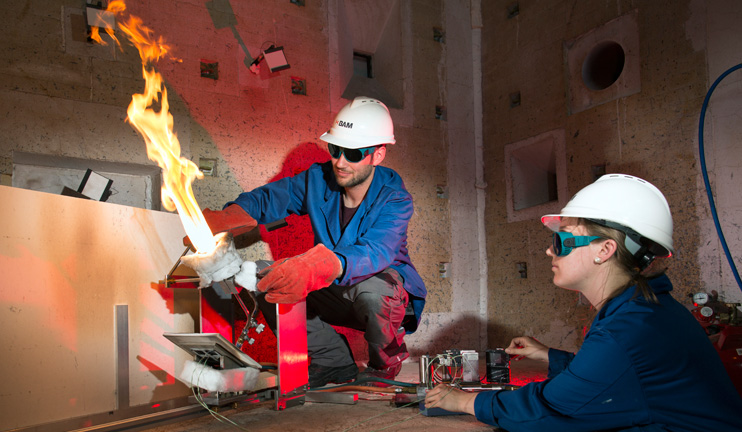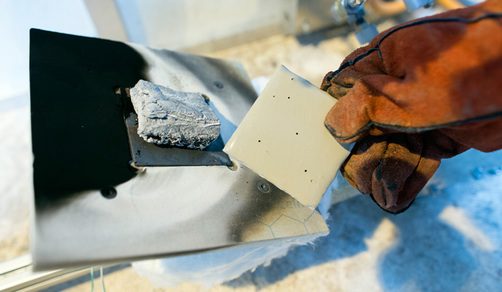
Marie-Bernadette Watolla (right) and Michael Morys, scientific employees at BAM, test a fire-prevention coating using a high-performance burner.
Source: BAM/Thomas Köhler
"Innovative materials, for example in lightweight construction, behave significantly differently during fires than conventional substances," says Dr. Simone Krüger, Head of BAM's "Future of Fire Resistance" [Zukunft Feuerwiderstand] project. The project team are developing new strategies and solutions in the area of fire resistance, with the goal of improving fire prevention. As well as focussing on new materials, the project is also looking at new testing methods, and an application-oriented form of assessment.
New materials
Composite materials, which are often used in lightweight construction, for example, can soften in the event of fire. The result: the component's load-carrying capacity fails. BAM is therefore investigating what sort of new fire-prevention coatings are suitable for composite materials to increase their fire resistance.
In addition, reactive fire-prevention coatings and fire tests are being trialled and developed with respect to more complex applications and geometries.
New testing methods
A further research focus for the project is the development of new testing methods that will allow, for example, fire-resistance levels to be investigated on a laboratory scale and in extreme fire scenarios. Fire tests on small samples allow a more cost-effective screening for product development.

A reactive fire-prevention coating before (right) and after the fire test: following contact with fire, the ceramic forms an isolating insulation layer.
Source: BAM/Thomas Köhler
New assessment of extreme cases
The assessment of fire resistance is an essential part of the research team's work. Here the trend is moving away from standardised assessment and towards the assessment of fire resistance in extreme scenarios or of complex components.
In the case of fires in industrial facilities, temperatures can reach over 1500 degrees Celsius, and fires can last for over two hours. In order to be able to judge the fire resistance of components under these extreme conditions, a newly-developed testing method with a high-performance burner is used, which can produce temperatures above 1500 °C.
Fire prevention of products with irregular geometric shapes, such as car fuel tanks, are also investigated using adapted testing methods. In addition, reactive fire-prevention coatings are assessed in an application-oriented manner with respect to their protective effect for components.
Interdisciplinary research project
BAM is an internationally recognised Centre of Excellence in the field of fire prevention. Experts from the following divisions are working together on the topic of "The future of fire resistance": Tanks for Dangerous Goods and Accident Mechanics; Mechanics of Polymers; Fire Engineering; Technology of Construction Materials; Technical Properties of Polymeric Materials; Sensors, Measurement and Testing Methods; Non-Destructive Testing; and Fibre Optic Sensors.
The results of this research project shall be incorporated into enhanced testing methods for fire prevention under extreme conditions, and into new fire-prevention coatings. In the long term, they shall also become part of national, European, and international directives and standards. In this way, BAM is helping to ensure that safety standards for fire prevention in Germany will continue to satisfy the strictest requirements in the future.


